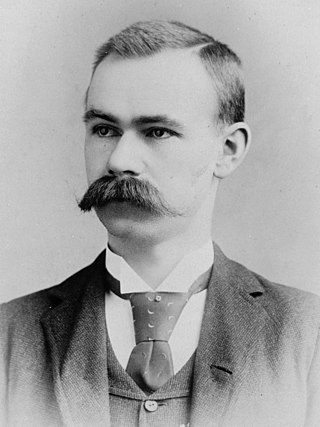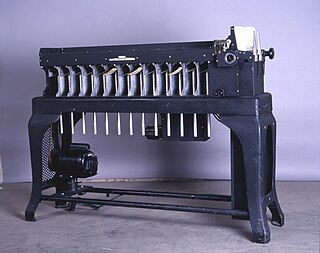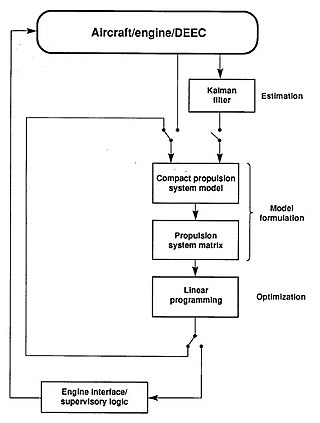
Herman Hollerith was a German-American statistician, inventor, and businessman who developed an electromechanical tabulating machine for punched cards to assist in summarizing information and, later, in accounting. His invention of the punched card tabulating machine, patented in 1884, marks the beginning of the era of mechanized binary code and semiautomatic data processing systems, and his concept dominated that landscape for nearly a century.
Information retrieval (IR) in computing and information science is the task of identifying and retrieving information system resources that are relevant to an information need. The information need can be specified in the form of a search query. In the case of document retrieval, queries can be based on full-text or other content-based indexing. Information retrieval is the science of searching for information in a document, searching for documents themselves, and also searching for the metadata that describes data, and for databases of texts, images or sounds.

A punched card is a piece of card stock that stores digital data using punched holes. Punched cards were once common in data processing and the control of automated machines.

A punched card sorter is a machine for sorting decks of punched cards.
A voting machine is a machine used to record votes in an election without paper. The first voting machines were mechanical but it is increasingly more common to use electronic voting machines. Traditionally, a voting machine has been defined by its mechanism, and whether the system tallies votes at each voting location, or centrally. Voting machines should not be confused with tabulating machines, which count votes done by paper ballot.
Electronic data processing (EDP) or business information processing can refer to the use of automated methods to process commercial data. Typically, this uses relatively simple, repetitive activities to process large volumes of similar information. For example: stock updates applied to an inventory, banking transactions applied to account and customer master files, booking and ticketing transactions to an airline's reservation system, billing for utility services. The modifier "electronic" or "automatic" was used with "data processing" (DP), especially c. 1960, to distinguish human clerical data processing from that done by computer.

The Powers Accounting Machine was an information processing device developed in the early 20th century for the U.S. Census Bureau. It was then produced and marketed by the Powers Accounting Machine Company, an information technology company founded by the machine's developer. The company thrived in the early 20th century as a producer of tabulating machines. It was a predecessor to the Unisys corporation.

Starting at the end of the nineteenth century, well before the advent of electronic computers, data processing was performed using electromechanical machines collectively referred to as unit record equipment, electric accounting machines (EAM) or tabulating machines. Unit record machines came to be as ubiquitous in industry and government in the first two-thirds of the twentieth century as computers became in the last third. They allowed large volume, sophisticated data-processing tasks to be accomplished before electronic computers were invented and while they were still in their infancy. This data processing was accomplished by processing punched cards through various unit record machines in a carefully choreographed progression. This progression, or flow, from machine to machine was often planned and documented with detailed flowcharts that used standardized symbols for documents and the various machine functions. All but the earliest machines had high-speed mechanical feeders to process cards at rates from around 100 to 2,000 per minute, sensing punched holes with mechanical, electrical, or, later, optical sensors. The operation of many machines was directed by the use of a removable plugboard, control panel, or connection box. Initially all machines were manual or electromechanical. The first use of an electronic component was in 1937 when a photocell was used in a Social Security bill-feed machine. Electronic components were used on other machines beginning in the late 1940s.

A keypunch is a device for precisely punching holes into stiff paper cards at specific locations as determined by keys struck by a human operator. Other devices included here for that same function include the gang punch, the pantograph punch, and the stamp. The term was also used for similar machines used by humans to transcribe data onto punched tape media.

The tabulating machine was an electromechanical machine designed to assist in summarizing information stored on punched cards. Invented by Herman Hollerith, the machine was developed to help process data for the 1890 U.S. Census. Later models were widely used for business applications such as accounting and inventory control. It spawned a class of machines, known as unit record equipment, and the data processing industry.
The APE(X)C, or All Purpose Electronic (X) Computer series was designed by Andrew Donald Booth at Birkbeck College, London in the early 1950s. His work on the APE(X)C series was sponsored by the British Rayon Research Association. Although the naming conventions are slightly unclear, it seems the first model belonged to the BRRA. According to Booth, the X stood for X-company.

The 1890 United States census was taken beginning June 2, 1890. The census determined the resident population of the United States to be 62,979,766, an increase of 25.5 percent over the 50,189,209 persons enumerated during the 1880 census. The data reported that the distribution of the population had resulted in the disappearance of the American frontier.
A card reader is a data input device that reads data from a card-shaped storage medium and provides the data to a computer. Card readers can acquire data from a card via a number of methods, including: optical scanning of printed text or barcodes or holes on punched cards, electrical signals from connections made or interrupted by a card's punched holes or embedded circuitry, or electronic devices that can read plastic cards embedded with either a magnetic strip, computer chip, RFID chip, or another storage medium.
A service bureau is a company that provides business services for a fee. The term has been extensively used to describe technology-based services to financial services companies, particularly banks. Service bureaus are a significant sector within the growing 3D printing industry that allow customers to make a decision whether to buy their own equipment or outsource production. Customers of service bureaus typically do not have the scale or expertise to incorporate these services into their internal operations and prefer to outsource them to a service bureau. Outsourced payroll services constitute a commonly provisioned service from a service bureau.
The IBM 101 Electronic Statistical Machine, introduced in 1952, combines in one unit the functions of sorting, counting, accumulating, balancing, editing, and printing of summaries of facts recorded in IBM cards.

A mechanical computer is a computer built from mechanical components such as levers and gears rather than electronic components. The most common examples are adding machines and mechanical counters, which use the turning of gears to increment output displays. More complex examples could carry out multiplication and division—Friden used a moving head which paused at each column—and even differential analysis. One model, the Ascota 170 accounting machine sold in the 1960s, calculated square roots.
Paper data storage refers to the use of paper as a data storage device. This includes writing, illustrating, and the use of data that can be interpreted by a machine or is the result of the functioning of a machine. A defining feature of paper data storage is the ability of humans to produce it with only simple tools and interpret it visually.

A control-flow diagram (CFD) is a diagram to describe the control flow of a business process, process or review.

The 14th Weather Squadron is a Geographically Separate Unit (GSU) of the 2nd Weather Group. The squadron is located in the Veach-Baley Federal Complex in Asheville, North Carolina. Its mission is military applied climatology. The 14 WS collects, protects and exploits authoritative climate data to optimize military and intelligence operations and planning in order to maximize the combat effectiveness of U.S. Department of Defense (DoD) personnel and weapons systems. It delivers environmental information worldwide to the United States Air Force (USAF), the Army, Unified Combatant Commands, the Intelligence Community, and the Department of Defense. The 14 WS also collaborates with the National Centers for Environmental Information (NCEI).
James Legrand Powers was a US inventor and entrepreneur, the founder of Powers Accounting Machine Company.











